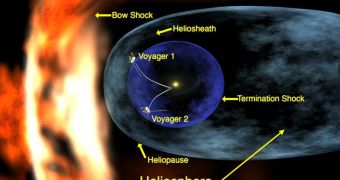It seems that nothing is standing still in this Universe. Not even our solar system. The phrase "faster than a speeding bullet" appears to be characterizing very well our solar system.
New data sent in by NASA's two Voyager spacecraft gave astronomers a whole new perspective. The two probes are now the most distant human made artifacts in space.
The unique perspective given by the enormous distance enables the probes to gather data that would be otherwise unavailable from Earth, thus they have accurately calculated the movement of the solar system.
The sun and the surrounding planets form a space entity that is roaming through the void of space at approximately 62,000 miles (100,000 kilometers) an hour.
It forms a bubble of solar wind, made up of charged particles coming from the sun that extend beyond the planets to form the heliosphere. Although electrically neutral atoms from interstellar space can penetrate this bubble, virtually all of the material in the heliosphere emanates from the Sun itself.
This bubble is shaped like a bullet and its edge collides with the Milky Way galaxy's magnetic field at a distance some 200 times farther from the Sun than Earth is.
A team of researchers led by Merav Opher at Virginia's George Mason University discovered that, just outside the solar system, this interstellar magnetic field is inclined at a 60-degree angle relative to the plane of the Milky Way.
This streamline shape is caused by the fact that the solar system strikes the magnetic field precisely at this angle.
"The shape of the solar system, this bullet, is really shaped by what lies ahead of us-the interstellar magnetic field," Opher said. The [prevailing] idea is that the environment just outside our solar system is patchy and turbulent," she added. "There are lots of stars exploding and dying outside our solar system."
The new observations have been made possible by the fact that the Voyager spacecraft, which are moving away from Earth in opposite directions, only recently reached the solar system's edge.

 14 DAY TRIAL //
14 DAY TRIAL //